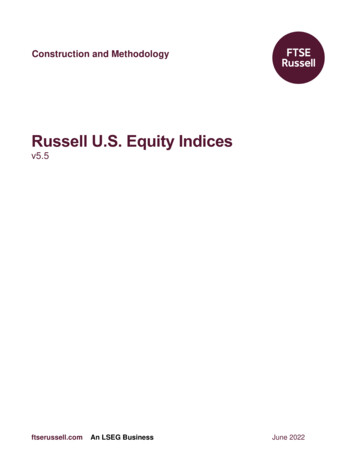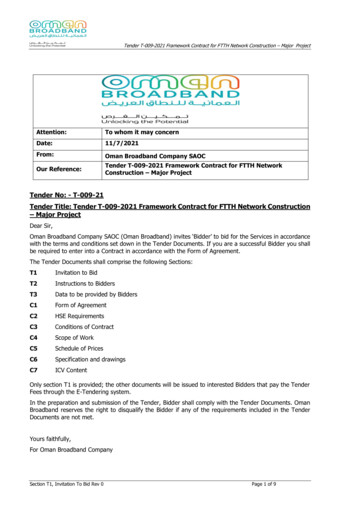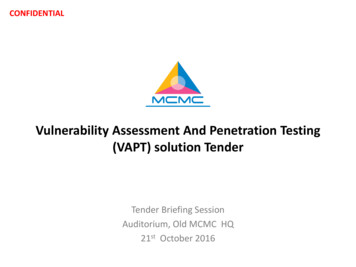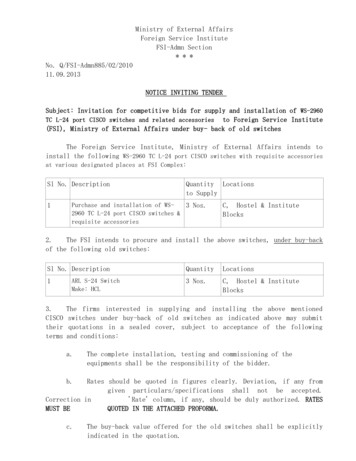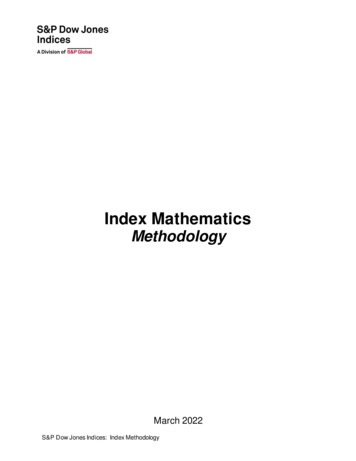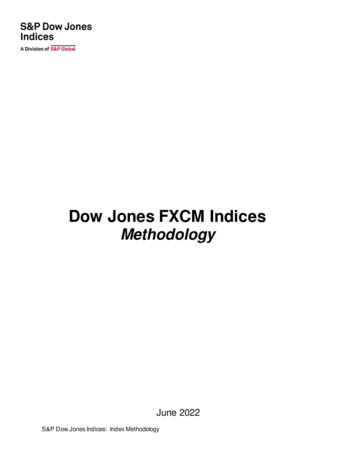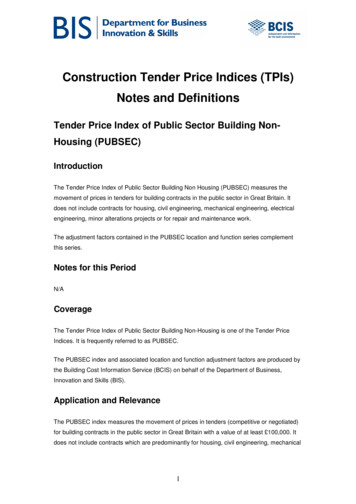
Transcription
Construction Tender Price Indices (TPIs)Notes and DefinitionsTender Price Index of Public Sector Building NonHousing (PUBSEC)IntroductionThe Tender Price Index of Public Sector Building Non Housing (PUBSEC) measures themovement of prices in tenders for building contracts in the public sector in Great Britain. Itdoes not include contracts for housing, civil engineering, mechanical engineering, electricalengineering, minor alterations projects or for repair and maintenance work.The adjustment factors contained in the PUBSEC location and function series complementthis series.Notes for this PeriodN/ACoverageThe Tender Price Index of Public Sector Building Non-Housing is one of the Tender PriceIndices. It is frequently referred to as PUBSEC.The PUBSEC index and associated location and function adjustment factors are produced bythe Building Cost Information Service (BCIS) on behalf of the Department of Business,Innovation and Skills (BIS).Application and RelevanceThe PUBSEC index measures the movement of prices in tenders (competitive or negotiated)for building contracts in the public sector in Great Britain with a value of at least 100,000. Itdoes not include contracts which are predominantly for housing, civil engineering, mechanical1
engineering, electrical engineering, minor alterations or projects for repair and maintenancework.The index is based on the rates for measured work contained in Bills of Quantities orquantified schedules for accepted tenders within the Public Sector so only projects where theprocurement process produces these documents can be included in the index.The price of mechanical and electrical services and other specialist items that are notincluded in the base schedule are not measured.PUBSEC is an 'All-In' index including both ‘fixed price’ and ‘variation of price’ projects in itscompilation. However, since 1990, very few ‘variation of price’ projects have been included inthe sample.Participating government departments include the Department for Education, the Departmentfor Work and Pensions, the Department of Health, the Home Office, the Ministry of Defence,the Department for Environment, Food and Rural Affairs, the Ministry of Justice and variousLocal Authorities in England, Scotland and Wales. Until 2011 the Scottish Government alsoparticipated.The indices may be used in estimating, cost-checking and fee negotiation on non housingpublic sector construction works. They are used by the Office for National Statistics (ONS) todeflate construction new orders for public sector non-housing excluding infrastructure fromcurrent to constant prices and in the calculation of Output Price Indices (OPIs).The PUBSEC index reflects the price level at the date of tender. The location and buildingfunction adjustment factors can be applied to determine an index adjusted for location andfunction, please see below for more guidance.Calculating a Building Project IndexThe PUBSEC index can be adjusted to estimate the index for a particular building project byusing the following simple formula to apply the location and function factors.[Estimated Project Index] [PUBSEC Index] x [Location Factor] x [Function Factor]where the following project criteria are available:Tender/Estimate Date of project.Location/County in which project is situated.Building Function/Type of project2
Below is an example of the calculation of an Estimated Project Index.ExampleTender/Estimate Date of project:July 20103Q2010 PUBSEC Index 171 (A)Project Location:Taunton, SomersetSouth West Location Factor 1.03 (B)Project Function:Children’s HomeHomes, Hostels and Barracks Function Factor 0.94 (C)Estimated Project Index A x B x CEstimated Project Index 171 x 1.03 x 0.94 166PublicationQuarterly and annual versions of PUBSEC are published. The quarters are calendar quarters(e.g. first quarter covers January, February and March). Projects are allocated to quarters bythe date for receipt of tenders.Annual indices are based on the mean of the quarterly indices and relate to the calendar year.The indices are published quarterly at 9.30am on the Monday following the second Friday ofthe last month in the quarter, i.e. in March, June, September and December.The latest calculated index values available will be for the quarter prior to the quarter of thedate of publication.There are no monthly index values.Revision PolicyA provisional PUBSEC index will first be published for the quarter prior to the publicationquarter. The first provisional index will be based on a small sample and the index is likely tochange over the next two quarters as additional project indices become available, but the3
index continues to be held provisional. Changes between the first provisional index and a firmindex are typically less than 4%.The index is normally held provisional for three quarters, after which it is published as a firmindex. The index value may change as the index becomes firm, but changes will normally besmall as the sample is unlikely to have increased and any change is likely to come from thesubsequent quarter as a result of the smoothing process.Once published as firm, the index will not be changed for revisions in the input data. A firmindex will only be changed in exceptional circumstances: to correct publication errors or in theevent of a change in methodology. If a revision to a firm index is necessary then the index willbe marked as ‘R’ for the current publication, but this marker will be removed in subsequentpublications. Changes in methodology will be recorded under notes and definitions. Anymajor changes or revisions will be pre-announced, where practicable, together with thereasons for revisions and how they are handled.Annual indices will always be updated to reflect changes in the quarterly series.RangeThe earliest available indices are for 1st quarter 1950.Calculation MethodEach project index is calculated from the price levels established by comparing the price ofitems to a minimum value of 25% for each trade or section of the Bills of Quantities withstandard base prices. Only items that appear in the base schedule can be matched. Theresultant factors are combined by applying weights representing the total value of each tradeor section. Preliminaries and other general charges are spread proportionally over each itemof the Bill of Quantities.In order to reduce the volatility of the raw PUBSEC indices (especially where sample sizesare small) the published indices from 1Q1990 are smoothed. The raw quarterly index iscalculated from the median of the project indices normalised by the location and functionadjustment factors from the quarter. The raw quarterly indices are smoothed by weighting50% of the current quarter and 25% of the preceding and following quarters. The PUBSECindex is therefore a smoothed median, current weighted index.Please will all users of these indices who are responsible for letting new build works in thepublic sector, and for which the works fall within the definition given in the introduction of4
these notes, ensure that Bills of Quantities and other tender information are submitted toBCIS for indexing at the following address,Freepost RLYL-ZTAC-GASYBCISParliament SquareLondonSW1P 3ADBaseThe PUBSEC indices are set at 100 at the base year of 1995.The following conversion factors can be used to convert the current PUBSEC index to otherbase dates.1975 100, multiply by 2.7781985 100, multiply by 1.263Superseded SeriesThe current PUBSEC index supersedes earlier versions as follows:SeriesTitleBaseNumberTo convertcurrentseries toearlier basemultiply by900QSSD Index of Building Tender Prices1975 1002.778901QSSD Index of Building Tender Prices1985 1001.263902Public Sector Tender Price Index1990 1001.012Further InformationEnquiries about the PUBSEC indices should be addressed to BCIS.Telephone: 44 (0)20 7695 1500Email: support@bcis.co.uk5
Keith Folwell from the Department for Business Innovation and Skills (BIS) is the statisticianresponsible for the PUBSEC indices.Telephone: 44 (0)20 7215 1248Email: keith.folwell@bis.gsi.gov.ukThe MIPS Index (Median Index of Public Sector), which has for many years been used forcapital planning of health projects by the Department of Health, was a rebased version of thePUBSEC index. It is therefore suggested that the PUBSEC index should be used in lieu ofMIPS which is no longer published.The conversion factor from MIPS (1975 100) to PUBSEC (1995 100) is 2.778 (i.e. MIPS PUBSEC Index x 2.778)The Department of Health's last issued recommended reporting level of MIPS was 480, whichis equivalent to PUBSEC 173.New schemes submitted for approval at Strategic Outline Case (SOC) and Outline BusinessCases (OBC) stages should be reported at PUBSEC 173; while schemes that have previouslybeen reported using MIPS should, at the next submission, be reported at PUBSEC equivalentreporting levels.The PUBSEC Location Study and PUBSEC Function Study are closely associated with thePUBSEC Tender Price Index. The Output Price Index for New Construction (2010): PublicNon-Housing is derived from the PUBSEC Tender Price Index.6
Location Study of the Tender Price Index of PublicSector Building Non-Housing (PUBSEC)IntroductionThe location study of the Tender Price Index of Public Sector Non-Housing (PUBSEC)provides a measure of the regional differences in tender price levels by the calculation oflocation factors.The PUBSEC location factors can be used in conjunction with the PUBSEC index todetermine a project index adjusted for geographical location.Notes for this PeriodN/ACoverageThe PUBSEC location factors form part of the Tender Price Indices and are produced by theBuilding Cost Information Service (BCIS) on behalf of the Department of Business, Innovationand Skills (BIS). They consist of the following:PUBSEC Location Study: ScotlandPUBSEC Location Study: NorthPUBSEC Location Study: WalesPUBSEC Location Study: MidlandsPUBSEC Location Study: EastPUBSEC Location Study: South WestPUBSEC Location Study: South EastPUBSEC Location Study: LondonApplication and RelevanceThe PUBSEC location study is an analysis of all projects used in the compilation of thePUBSEC index sampled in the most recent 12 quarters. This study provides a measure ofthe regional differences in tender price levels by the calculation of location factors.Please see above for a worked example of the calculation of a PUBSEC project index whichhas been adjusted for location and function.7
Regional CoverageThe PUBSEC location factors cover the following eight locations:ScotlandNorthWalesMidlandsEastSouth WestSouth EastLondonThe locations are formed of the following counties and unitary authorities.1. SCOTLANDMorayPerth and re (E)AngusStirlingArgyll and Bute2. NORTHAyrshire (E)Ayrshire (N)Ayrshire s and GallowayBuryDunbartonshire (E)CalderdaleDunbartonshire poolInverclydeKingston Upon HullLanarkshire (N)KirkleesLanarkshire (S)KnowsleyLothian (E)LancashireLothian (Mid)LeedsLothian (W)Lincolnshire (NE)8
Lincolnshire (N)Merthyr TydfilLiverpoolMonmouthshireManchesterNeath and Port TalbotMiddlesbroughNewportNewcastle Upon TynePembrokeshireNorthumberlandPowysOldhamRhondda, Cynon, TaffRedcar and ClevelandSwanseaRochdaleTorfaenRotherhamVale of GlamorganSalfordWrexhamSefton4. MIDLANDSSheffieldSt. ford and WorcesterTyneside (N)LeicesterTyneside ptonshireWirralNottinghamshireYorkRutlandYorkshire (E. Rdg)SandwellYorkshire (N)ShropshireSolihull3. WALESStaffordshireAberconwy and ColwynStoke-on-TrentAngleseyWalsallBlaenau GwentWarwickshireBridgendWolverhamptonCaerphilly5. ssexGwynedd9
HertfordshireLutonMilton KeynesNorfolkSuffolk6. SOUTH WESTBath and NE shireGloucestershire (S)PooleSomersetSomerset (NW)ThamesdownWiltshire7. SOUTH EASTBerkshireBrighton and urreySussex (E)Sussex (W)8. LONDONAll London Boroughs10
PublicationThe PUBSEC location factors are published quarterly when the sample size is at least four.The quarters are calendar quarters (e.g. first quarter covers January, February and March).The factors are published quarterly at 9.30am on the Monday following the second Friday ofthe last month in the quarter, i.e. in March, June, September and December.The latest factors available will be for the quarter prior to the date of publication.There are no monthly or annual location factors.Revision PolicyProvisional PUBSEC location factors will first be published for the quarter prior to thepublication quarter. Factors are normally held provisional for three quarters, after which theyare published as firm. The provisional factors may change at each publication and maychange as they become firm.Once published as firm, the factors will not be changed for revisions in the input data. A firmlocation factor will only be changed in exceptional circumstances: to correct publication errorsor in the event of a change in methodology. If a revision is necessary then the location factorwill be marked as ‘R’ for the current publication, but this marker will be removed insubsequent publications. Changes in methodology will be recorded under notes anddefinitions. Any major changes or revisions will be pre-announced, where practicable,together with the reasons for revisions and how they are handled.RangeThe earliest available location factors for PUBSEC are for the first quarter 1985.Calculation MethodThe location factors are derived from the location study. The location study standardises allindices and classifies them by geographical location. Projects are allocated to quarters by thedate for receipt of tenders. In order that the location factors reflect the most current indices, arolling period of the most recent 12 quarters is used. The number of indices used to create thelocation factors determines the sample size. Location factors are only published where thesample size is at least 4.11
BaseThe PUBSEC location factors are applicable to the PUBSEC Tender Price Index at any basedate.Superseded SeriesN/AFurther InformationQueries should be addressed to BCIS.Telephone: 44 (0)20 7695 1500Email: support@bcis.co.ukThe responsible statistician at the Department for Business Innovation and Skills is KeithFolwell (email: Keith.Folwell@bis.gsi.gov.uk, telephone: 44(0)20 7215 1248).12
Function Study of the Tender Price Index of PublicSector Building Non-Housing (PUBSEC)IntroductionThe function study of the Tender Price Index of Public Sector Non-Housing (PUBSEC)provides a measure of differences in tender price levels due to building function by thecalculation of building function factors.The PUBSEC function factors can be used in conjunction with the PUBSEC index todetermine a project index adjusted for building function.Notes for this PeriodN/ACoverageThe PUBSEC function factors form part of the Tender Price Indices and are produced by theBuilding Cost Information Service (BCIS) on behalf of the Department of Business, Innovationand Skills (BIS). They consist of the following:PUBSEC Function Study: Courts, Police Stations and PrisonsPUBSEC Function Study: Hospitals, Clinics and Day CentresPUBSEC Function Study: Schools, Colleges and Training CollegesPUBSEC Function Study: Homes, Hostels and BarracksPUBSEC Function Study: Offices, Technical Buildings and FactoriesPUBSEC Function Study: MiscellaneousApplication and RelevanceThe PUBSEC function study is an analysis of all projects used in the compilation of thePUBSEC index sampled in the most recent 12 quarters. This study provides a measure ofdifferences in tender price levels due to building function by the calculation of function factors.Please see above for a worked example of the calculation of a PUBSEC project index whichhas been adjusted for location and function.13
Building Function CoverageThe PUBSEC function factors cover the following types of building function:1. Courts, Police Stations and Prisons2. Hospitals, Clinics and Day Centres3. Schools, Colleges and Training Colleges4. Homes, Hostels and Barracks5. Offices, Technical Buildings and Factories6. MiscellaneousPublicationThe PUBSEC function factors are published quarterly when the sample size is at least four.The quarters are calendar quarters (e.g. first quarter covers January, February and March).The factors are published quarterly at 9.30am on the Monday following the second Friday ofthe last month in the quarter, i.e. in March, June, September and December.The latest factors available will be for the quarter prior to the date of publication.There are no monthly or annual function factors.Revision PolicyProvisional PUBSEC function factors will first be published for the quarter prior to thepublication quarter. Factors are normally held provisional for three quarters, after which theyare published as firm. The provisional factors may change at each publication and maychange as they become firm.Once published as firm, the factors will not be changed for revisions in the input data. A firmfunction factor will only be changed in exceptional circumstances: to correct publication errorsor in the event of a change in methodology. If a revision to a firm index is necessary then thefactor will be marked as ‘R’ for the current publication, but this marker will be removed insubsequent publications. Changes in methodology will be recorded under notes anddefinitions. Any major changes or revisions will be pre-announced, where practicable,together with the reasons for revisions and how they are handled.RangeThe earliest available building function factors for PUBSEC are for the first quarter 1985.14
Calculation MethodThe function factors are derived from the function study. The function study standardises allindices and classifies them by building function. Projects are allocated to quarters by the datefor receipt of tenders. In order that the function factors reflect the most current indices, arolling period of the most recent 12 quarters is used. The number of indices used to create thefunction factors determines the sample size. Function factors are only published where thesample size is at least 4.BaseThe PUBSEC function factors are applicable to the PUBSEC Tender Price Index at any basedate.Superseded SeriesN/AFurther InformationQueries should be addressed to BCIS.Telephone: 44 (0)20 7695 1500Email: support@bcis.co.ukThe responsible statistician at the Department for Business Innovation and Skills is KeithFolwell (email: Keith.Folwell@bis.gsi.gov.uk, telephone: 44(0)20 7215 1248).15
Tender Price Index of Road Construction (ROADCON)IntroductionThe Tender Price Index of Road Construction (ROADCON) measures the movement of pricesin tenders for road construction contracts in England, Scotland and Wales. It includes roadcontracts for New Construction, Motorway Widening and Major Maintenance schemes costingover 100,000.The adjustment factors contained in the ROADCON location, road type and value seriescomplement this series.Notes for this PeriodN/ACoverageThe Tender Price Index of Road Construction is one of the Tender Price Indices. It isfrequently referred to as ROADCON.ROADCON and associated location, type and value adjustment factors are produced by theBuilding Cost Information Service (BCIS) on behalf of the Department of Business, Innovationand Skills (BIS).Application and RelevanceThe ROADCON index measures the movement of prices in tenders (competitive ornegotiated) for road contracts in England, Scotland and Wales.The index is based on priced rates contained in accepted tenders for New Construction,Motorway Widening and Major Maintenance schemes costing over 100,000 (prior to April2011, the minimum value was 250,000), obtained from the Highways Agency and LocalAuthorities in England, Scotland and Wales.The ROADCON is an 'All-In' index including both ‘fixed price’ and ‘variation of price’ projectsin its compilation. However, since 1990, very few ‘variation of price’ projects have beenincluded in the sample.The indices may be used in estimating, cost-checking and fee negotiation on roadconstruction projects. They are used, in addition to other Tender Price Indices, by the Office16
for National Statistics (ONS) to deflate construction new orders for infrastructure from currentto constant prices and in the calculation of Output Price Indices (OPIs).The ROADCON index reflects the price level at the date of tender. The location, road typeand value adjustment factors can be applied to determine an index adjusted for location, roadtype and value, please see below for more guidance.Calculating a Road Project IndexThe ROADCON index can be adjusted to estimate the index for a particular road project byusing the following simple formula to apply the location, road type and value factors.[Estimated Road Project Index] [ROADCON Index] x [Location Factor] x [Type Factor] x[Value Factor]where the following project criteria are available:Tender/Estimate Date of road projectLocation/County in which road project is situatedType of road projectTender/Estimate Value of road projectBelow is an example of the calculation of an Estimated Project Index.ExampleTender/Estimate Acceptance Date of project:July 20103Q2010 ROADCON Tender Price Index 168 (A)Project Location:Matlock, DerbyshireMidlands Location Factor 1.00 (B)Road Type:New MotorwayNew Construction Road Type Factor 1.03 (C)Tender Value 30 million 30 million Value Factor 0.93 (D)Estimated Road Project Index A x B x C x D17
Estimated Road Project Index 168 x 1.00 x 1.03 x 0.93 161PublicationQuarterly and annual versions of ROADCON are published. The quarters are calendarquarters (e.g. first quarter covers January, February and March). Projects are allocated toquarters by the date for receipt of tenders.Annual indices are based on the mean of the quarterly indices and relate to the calendar year.The indices are published quarterly at 9.30am on the Monday following the second Friday ofthe last month in the quarter, i.e. in March, June, September and December.The latest calculated index values available will be for the quarter prior to the quarter of thedate of publication.There are no monthly index values.Revision PolicyA provisional ROADCON index will first be published for the quarter prior to the publicationquarter. The first provisional index will be based on a small sample and the index is likely tochange over the next two quarters as additional project indices become available, but theindex continues to be held provisional. Changes between the first provisional index and a firmindex are typically less than 8%.The index is normally held provisional for three quarters, after which it is published as a firmindex. The index value may change as the index becomes firm.Once published as firm, the index will not be changed for revisions in the input data. A firmindex will only be changed in exceptional circumstances: to correct publication errors or in theevent of a change in methodology. If a revision is necessary then the index will be marked as‘R’ for the current publication, but this marker will be removed in subsequent publications.Changes in methodology will be recorded under notes and definitions. Any major changes orrevisions will be pre-announced, where practicable, together with the reasons for revisionsand how they are handled.Annual indices will always be updated to reflect changes in the quarterly series.RangeThe earliest available indices are for 1st quarter 1985.18
Calculation MethodProject indices are calculated from the price levels established by comparing the price ofitems to a minimum value of 25 per cent for each trade or section of the Bills of Quantitieswith standard base prices. The resultant factors are combined by applying weightsrepresenting the total value of each trade or section. Preliminaries and other general chargesare spread proportionally over each item of the Bills of Quantities.In order to reduce the volatility of the raw ROADCON Index (especially where sample sizesare small) the published indices are smoothed. The quarterly medians of the adjusted (forroad type, location and contract size) project indices divided by the public sector buildingtender price index for that quarter, are smoothed by a Kalman filter (equivalent to a first orderBayesian steady state model) after transformation to normality. The quarterly index isobtained by reversing the transformation on the result of the smoothing and then multiplyingby the public sector building tender price index.The ROADCON index is therefore a smoothed median, current weighted index.Please will all users of these indices who are responsible for letting road works contracts, andfor which the works fall within the definition given in the introduction of these notes, ensurethat Bills of Quantities and other tender information are submitted to BCIS for indexing at thefollowing address,Freepost RLYL-ZTAC-GASYBCISParliament SquareLondonSW1P 3ADBaseThe ROADCON index is set at 100 at the base year of 1995.The following conversion factors can be used to convert the ROADCON index to other basedates.1985 100, multiply by 1.4151990 100, multiply by 1.245Superseded SeriesN/A19
Further InformationEnquiries about the indices should be addressed to BCIS.Telephone: 44 (0)20 7695 1500Email: support@bcis.co.ukKeith Folwell from the Department for Business Innovation and Skills (BIS) is the statisticianresponsible for the ROADCON indices.Telephone: 44 (0)20 7215 1248Email: keith.folwell@bis.gsi.gov.ukThe ROADCON Tender Price Index Location Study, ROADCON Tender Price Index RoadType Study and the ROADCON Tender Price Index Value Study are closely associated withthe ROADCON Tender Price Index.The Output Price Index for New Construction (2010): Infrastructure is derived fromROADCON as well as other, currently unpublished, Tender Price Indices calculated by BCIS.20
Location Study of the Tender Price Index of RoadConstruction (ROADCON)IntroductionThe location study of the Tender Price Index of Road Construction (ROADCON) provides ameasure of the regional differences in tender price levels by the calculation of location factors.The ROADCON location factors can be used in conjunction with the ROADCON index todetermine a project index adjusted for geographical location.Notes for this PeriodN/ACoverageThe ROADCON location factors form part of the Tender Price Indices and are produced bythe Building Cost Information Service (BCIS) on behalf of the Department of Business,Innovation and Skills (BIS). They consist of the following:ROADCON Location Study: ScotlandROADCON Location Study: NorthROADCON Location Study: WalesROADCON Location Study: MidlandsROADCON Location Study: EastROADCON Location Study: South WestROADCON Location Study: South EastROADCON Location Study: LondonApplication and RelevanceThe ROADCON location study is an analysis of all projects used in the compilation of theROADCON index sampled in the most recent 12 quarters. This study provides a measure ofthe regional differences in tender price levels by the calculation of location factors.Please see above for a worked example of the calculation of a ROADCON project indexwhich has been adjusted for location, function and project value.21
Regional CoverageThe ROADCON location factors cover the following eight locations:ScotlandNorthWalesMidlandsEastSouth WestSouth EastLondonThe locations are formed of the following counties and unitary authorities.1. SCOTLANDMorayPerth and re (E)AngusStirlingArgyll and Bute2. NORTHAyrshire (E)Ayrshire (N)Ayrshire s and GallowayBuryDunbartonshire (E)CalderdaleDunbartonshire poolInverclydeKingston Upon HullLanarkshire (N)KirkleesLanarkshire (S)KnowsleyLothian (E)LancashireLothian (Mid)LeedsLothian (W)Lincolnshire (NE)22
Lincolnshire (N)Merthyr TydfilLiverpoolMonmouthshireManchesterNeath and Port TalbotMiddlesbroughNewportNewcastle Upon TynePembrokeshireNorthumberlandPowysOldhamRhondda, Cynon, TaffRedcar and ClevelandSwanseaRochdaleTorfaenRotherhamVale of GlamorganSalfordWrexhamSefton4. MIDLANDSSheffieldSt. ford and WorcesterTyneside (N)LeicesterTyneside ptonshireWirralNottinghamshireYorkRutlandYorkshire (E. Rdg)SandwellYorkshire (N)ShropshireSolihull3. WALESStaffordshireAberconwy and ColwynStoke-on-TrentAngleseyWalsallBlaenau GwentWarwickshireBridgendWolverhamptonCaerphilly5. ssexGwynedd23
HertfordshireLutonMilton KeynesNorfolkSuffolk6. SOUTH WESTBath and NE shireGloucestershire (S)PooleSomersetSomerset (NW)ThamesdownWiltshire7. SOUTH EASTBerkshireBrighton and urreySussex (E)Sussex (W)8. LONDONAll London Boroughs24
PublicationThe ROADCON location factors are published quarterly when the sample size is at least four.The quarters are calendar quarters (e.g. first quarter covers January, February and March).The factors are published quarterly at 9.30am on the Monday following the second Friday ofthe last month in the quarter, i.e. in March, June, September and December.Th
The price of mechanical and electrical services and other specialist items that are not included in the base schedule are not measured. PUBSEC is an 'All-In' index including both 'fixed price' and 'variation of price' projects in its compilation. However, since 1990, very few 'variation of price' projects have been included in the sample. Participating government departments .
